Exploring the animal kingdom reveals a fascinating array of species whose names begin with the letter ‘N.’ Each animal contributes unique traits to their ecosystems, from the well-armored Numbat to the deep-diving Narwhal.
The names of animals that start with ‘n’ are an entrance into understanding their biology and ecological roles. In alphabetical lists, such as those dealing with the animal alphabet, creatures starting with ‘N’ showcase the diversity of life forms adapted to different environments around the globe.
The animal alphabet is more than just a mnemonic device; it reflects a systematic approach to cataloging species. Animals like the nocturnal Nightingale, the Nile Crocodile, and the North American Beaver are identified by their names and distinct behaviors and habitats.
These entries serve as waypoints for deeper exploration into each species’ status, from common creatures to those facing conservation challenges. Emphasizing a scientific perspective, listing animals alphabetically provides clarity and an organized framework for learning.
It offers an educational resource for understanding the vast tapestry of animal life beginning with ‘N’, from the smallest Nematode to the stately Nyala, framing a world where every species, regardless of its place in the alphabet, is integral to the symphony of biodiversity.
Newt

The newt is a small, vividly hued amphibian renowned for its regenerative capabilities, allowing the regrowth of limbs, organs, and even parts of its heart. They inhabit moist, cool environments ranging from North America to Europe and Asia. During breeding season, newts exhibit a vivid color change, a spectacle that contrasts their normally muted terrestrial tones. Newts are semiaquatic, transitioning between aquatic larval, terrestrial juvenile (eft), and adult stages.
| Habitat | Lifespan | Diet |
|---|---|---|
| Aquatic/Terrestrial | 6-15 years | Insects, larvae |
They are integral to their ecosystems as both predators and prey, contributing to the biological balance of their habitats. Conservation efforts are paramount for species affected by habitat loss and pollution.
Night Adder
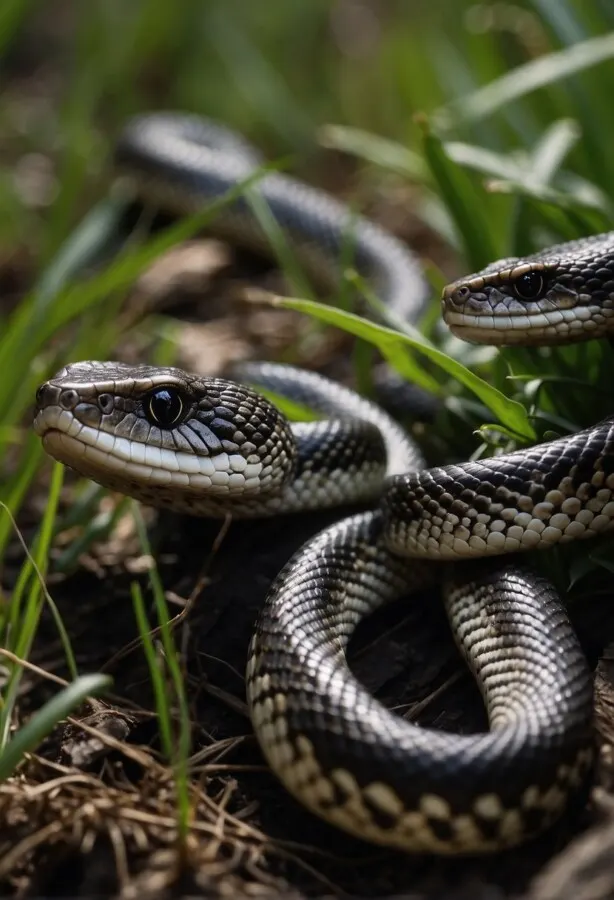
The Night Adder (Causus spp.) is a venomous snake native to Africa. Recognized by its small, sleek frame, this snake defies its nocturnal-sounding name by being diurnal. Predominantly preying on amphibians, its diet mainly consists of frogs and toads.
Reproduction results in clutches averaging about 24 eggs. Listed as of “Least Concern” by conservation statuses, the Night Adder does not face immediate threats to its population. Its adaptability has enabled a stable presence across varying African habitats.
Night Snake
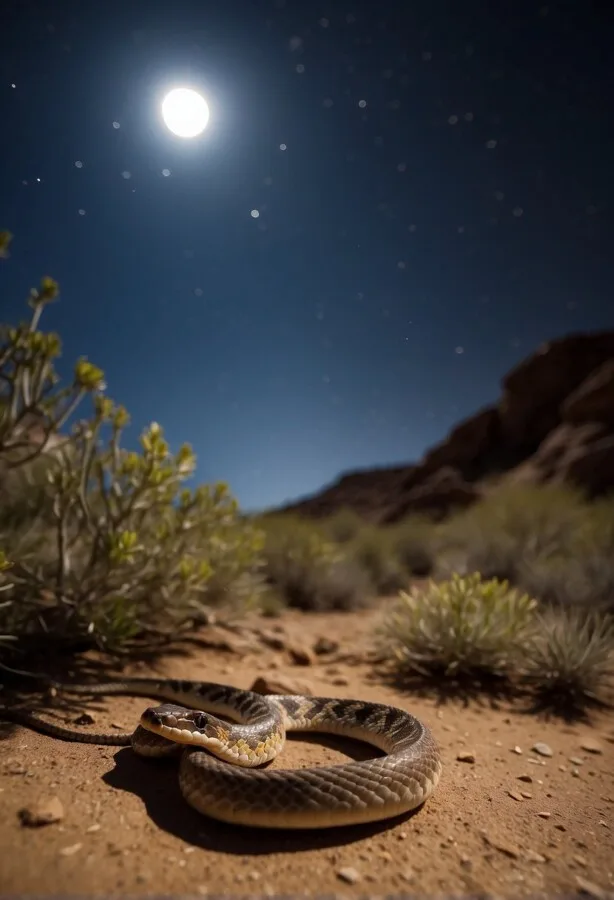
The Night Snake (Hypsiglena torquata) is a species within the Colubridae family, thriving in North America. Recognized by its distinctive triangular-shaped head and typically pale gray or beige coloration, it exhibits dark grey or brown blotches along its back. As a nocturnal predator, it preys primarily on lizards, frogs, and insects. The species is mildly venomous, leveraging rear fangs to subdue its victims.
| Status | Habitat | Diet | Features | Venom |
|---|---|---|---|---|
| Least Concern | North-America | Lizards, frogs, insects | Triangular head, gray/beige with blotches | Mildly venomous |
Categorizing under “Least Concern,” Night Snakes maintain a stable estimated population exceeding 100,000. Their harmless nature to humans positions them away from critical conservation focus.
Nile Crocodile
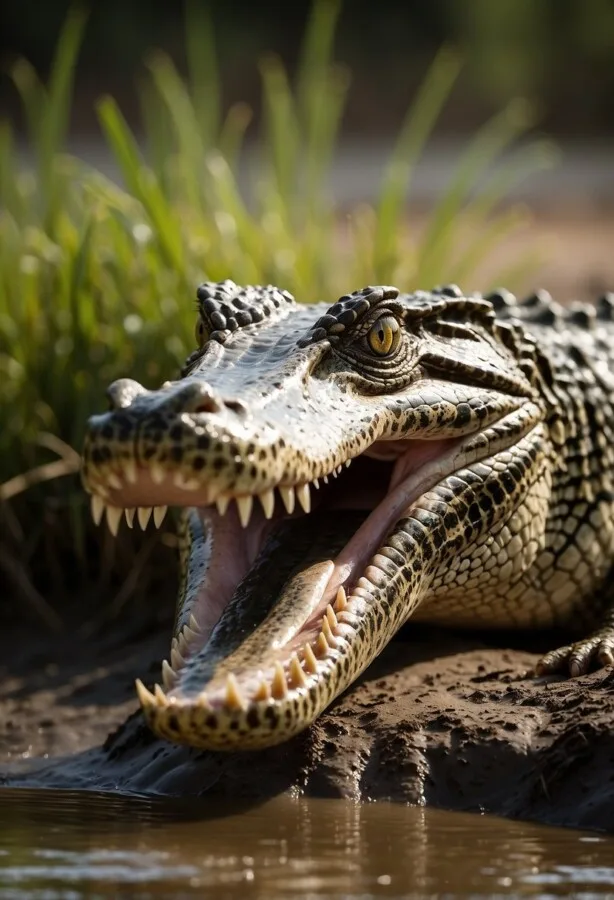
The Nile crocodile (Crocodylus niloticus) is a formidable reptilian predator native to freshwater habitats across Africa. Commanding their territory with a conservation status of Least Concern, they predominantly feast on fish, birds, and occasionally larger mammals.
| Classification | Information |
|---|---|
| Kingdom | Animalia |
| Phylum | Chordata |
| Class | Reptilia |
| Order | Crocodilia |
| Family | Crocodylidae |
| Genus | Crocodylus |
| Species | C. niloticus |
Nile crocodiles are distinguished by their V-shaped snouts and formidable jaw strength, adaptations that have been central to their survival. They exhibit complex behaviors, such as cooperative hunting, and play a crucial role in their ecosystems as apex predators and keystone species.
Narwhal

The narwhal (Monodon monoceros), often termed the “unicorn of the sea,” is a distinctive Arctic whale recognized for its long, spiral tusk protruding from its head. This tusk is actually an elongated upper left canine, which can reach lengths of up to 10 feet. Males primarily sport this feature, and it’s thought to play a role in mating rituals and dominance.
Narwhals predominantly inhabit the frigid waters of the Canadian Arctic and Greenland. They feed on fish, shrimp, and squid, employing echolocation for navigation and hunting in murky, ice-covered waters. Conservation status is currently near threatened, with climate change posing significant risks and could push these to the endangered species list.
Nautilus

The Nautilus is a marine mollusk with a distinct spiral shell, consisting of multiple chambers. It’s related to octopuses, squids, and cuttlefish, belonging to the family Nautilidae. These creatures inhabit tropical coral reefs, typically below 2,000 feet, avoiding warmer shallow waters.
Key Characteristics:
- Depth Range: Prefer deep slopes near coral reefs
- Shell Chambers: Utilized for buoyancy control
- Tentacles: Up to 90, used for capturing prey
Featuring a primitive yet effective jet propulsion system, nautiluses are skilled navigators of their deep-sea habitats. They are considered ‘living fossils,’ showing little change over millions of years, and play a role in oceanic ecosystems as scavengers.
See Related: Incredible Animals With Short Attention Spans
Needlefish
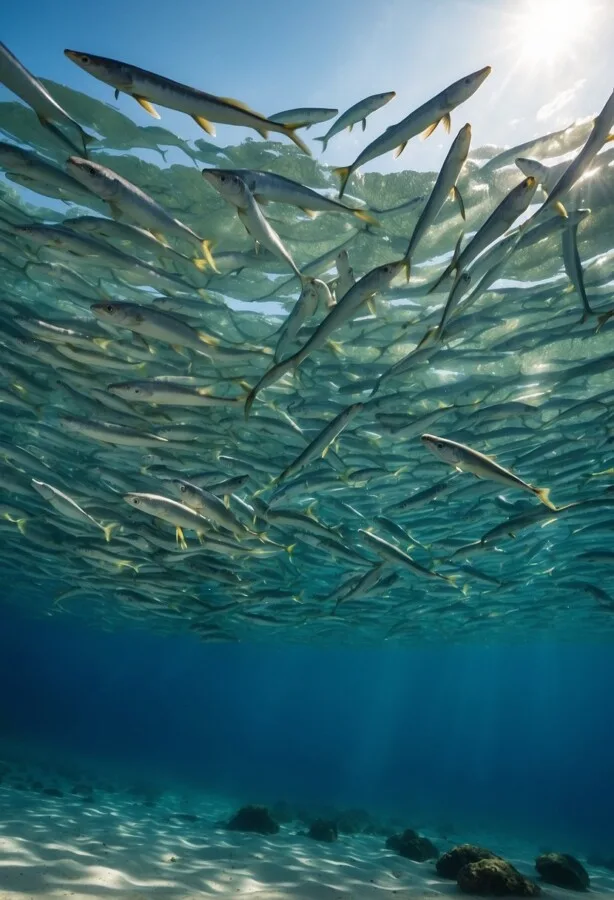
Needlefish (Belonidae family) manifest as slender, marine fish distinguished by long, beak-like jaws housing sharp teeth. They habituate tropical and subtropical oceans globally, often skimming the surface at night for food. Predominantly piscivorous, these fish impale prey using their pointed snouts. Displaying iridescent blue-green hues, they can reach over a meter in length. While generally categorized as of “Least Concern” conservation status, they pose a risk due to their attraction to light, leading to hazardous human encounters. Their rostrum can inflict serious injuries, so caution amongst them is advised.
Neon Tetra
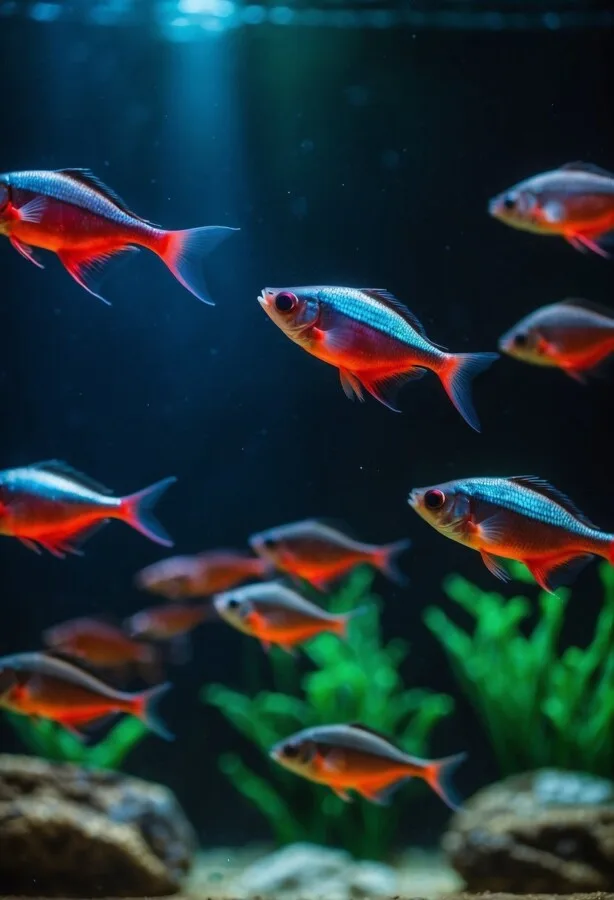
The Neon Tetra (Paracheirodon innesi) is a vibrant freshwater fish natively inhabiting South American Amazon basin streams. Renowned for their striking iridescent coloration, these fish enhance tropical aquariums worldwide. Neon Tetras thrive in warm, acidic waters, preferring environments with subdued lighting and ample plant coverage.
- Size: Small, usually reaching up to 1.5 inches.
- Diet: Omnivorous, feeding on algae, small invertebrates, and fish flakes in captivity.
- Aquarium Conditions: Optimal at 72-76°F with a pH of 6.0-7.0.
Their peaceful demeanor and schooling nature make them a top choice for communal tanks, contributing to their popularity among aquarists.
Nile Perch
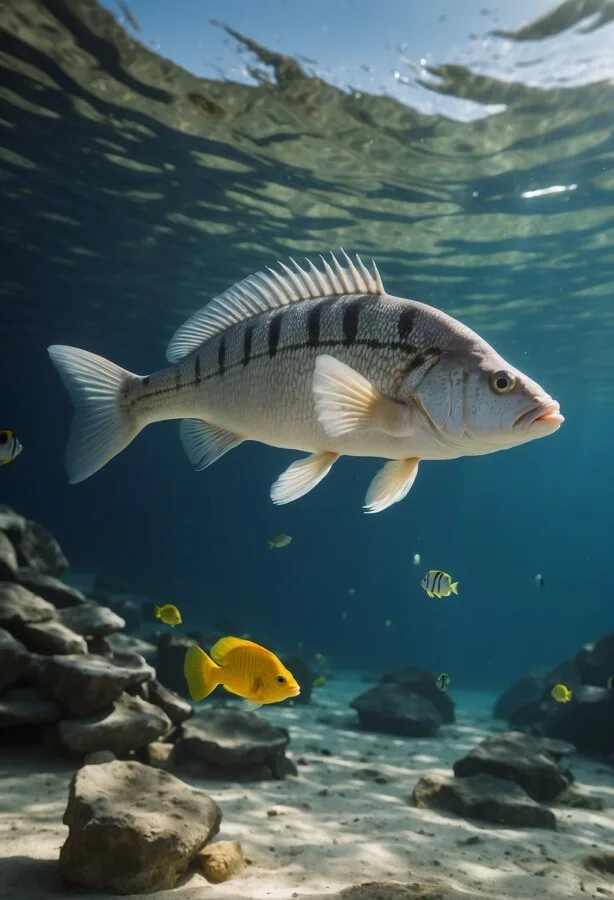
The Nile perch (Lates niloticus), a freshwater fish native to Africa’s inland waters, is notable for its large size and high density in favorable habitats. Found across tropical African waters, it thrives in diverse fresh water settings from rivers to deep lake areas, avoiding environments like swamps and the pelagic zone. This piscivore’s diet consists of smaller fish and various invertebrates. Its distribution spans from the Nile River basin to other river systems and African Great Lakes, reflecting its adaptability and potency as a top predator in these ecosystems.
Natterjack
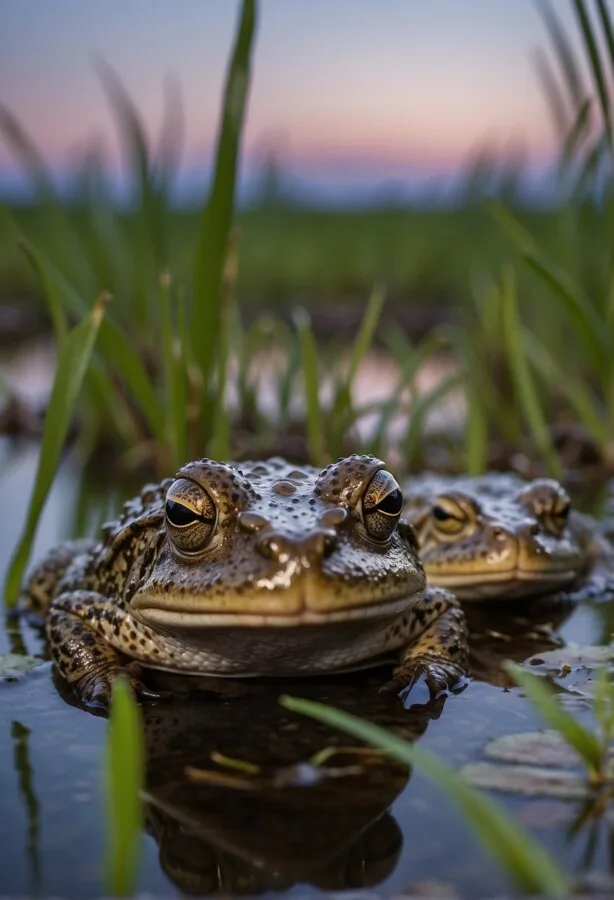
The Natterjack Toad (Epidalea calamita) distinguishes itself by a yellow line running down its back. These amphibians prefer sandy habitats near coastal regions across Eurasia, predominantly in Western Europe. They are distinguished by their distinctive mating call and are known for their unique, fast-paced crawl. As primarily nocturnal creatures, Natterjacks feed on insects such as worms and spiders. Conservation efforts focus on preserving their delicate dune ecosystems, as they are threatened by habitat loss.
Nightingale
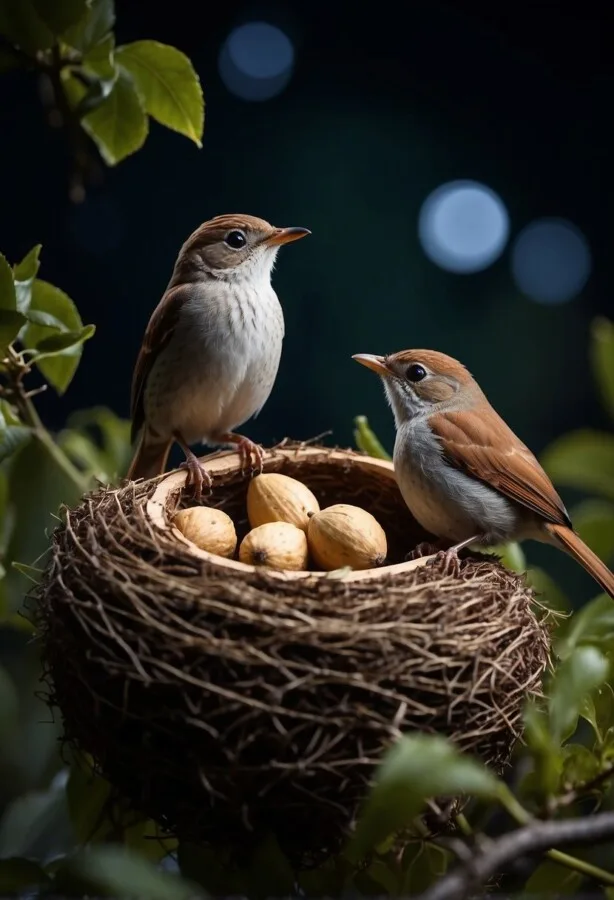
Scientific Name: Luscinia megarhynchos
The nightingale is a small bird renowned for its powerful and beautiful song. It belongs to the family Muscicapidae. Found in Europe, Asia, and parts of Africa, these birds prefer dense forests and scrubs as their habitat. Nightingales are migratory, wintering in sub-Saharan Africa.
Diet:
- Fruits
- Nuts
- Seeds
- Insects
Conservation Status: Least Concern
Nightingales are elusive and more often heard than seen. They feed primarily at dawn or dusk, foraging for food on the ground. Despite facing habitat loss, their population remains stable, avoiding the immediate threat of extinction.
Nightjar

Nightjars are nocturnal birds known for their exceptional camouflage and are predominantly insectivores, capturing prey like moths and flies mid-flight. This bird family, Caprimulgidae, spans various continents, including North and South America. Adapted to twilight living, nightjars exhibit muted plumage mirroring the woodland habitats they frequent.
Diet:
- Ants
- Beetles
- Caterpillars
- Grasshoppers
- Midges
- Mosquitos
Habitat:
- Woodlands
- Savannas
- Shrublands
Due to their cryptic nature, estimating population size is challenging, making conservation status assessments difficult. However, habitat preservation remains vital for their sustenance.
Northern Bobwhite
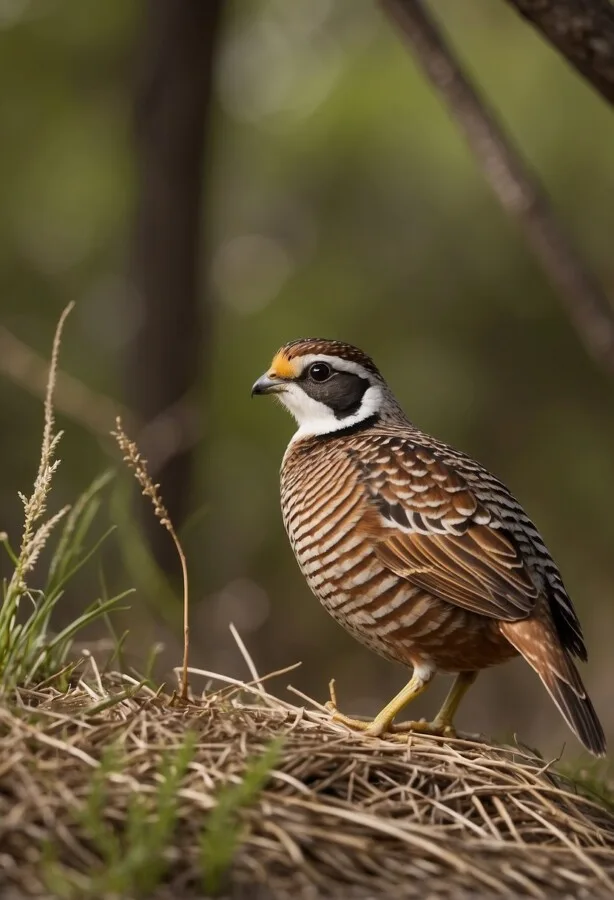
The Northern Bobwhite, scientifically named Colinus virginianus, is a ground-dwelling bird native to North America. Recognizable by its rich, whistled “bob-white” call, this species exhibits a dappled brown plumage ideal for camouflage. Typically living in groups, they show a preference for grassy or pine-dominated ecosystems.
- Conservation Status: Near Threatened
- Habitat: Grasslands, Woodlands
- Behavior: Flock-oriented
Despite their adaptability, bobwhite populations have declined due to habitat loss and changes in land use. Conservation efforts focus on habitat management and research to halt this downward trend.
Northern Cardinal

The Northern Cardinal is a mid-sized songbird known for its distinctive appearance and melodious calls. With a body length of 8.3-9.3 inches and a wingspan reaching 12.2 inches, these birds are easily recognizable by their raised crest and bright coral beak. Males display a vibrant cardinal red plumage, while females don an olive-brown shade with red highlights. Exhibiting sexual dimorphism, males are typically larger than females. Native to North and Central America, the species prefers woodland edges and gardens. Their diet consists mainly of seeds and fruits, complemented by insects.
- Body Length: 8.3-9.3 inches
- Wingspan: 9.8-12.2 inches
- Diet: Seeds, fruits, insects
- Habitat: Woodland edges, gardens
Northern Flicker

The Northern Flicker (Colaptes auratus) falls within the woodpecker family, Picidae. It’s distinguished by its brown plumage with black bars and a distinguishable white rump visible in flight. Their diet primarily consists of ants and beetles, foraging mainly on the ground.
Habitat:
- Central and North America
- Woodlands, edges, and clearings
Conservation Status:
- Least Concern
Identifying traits include:
- Size: Large compared to other woodpeckers
- Bill: Slightly curved for insect foraging
Despite being a woodpecker, its ground foraging habit is atypical. The flicker’s adaptation to terrestrial feeding underscores an ecological niche among avian species.
Northern Harrier
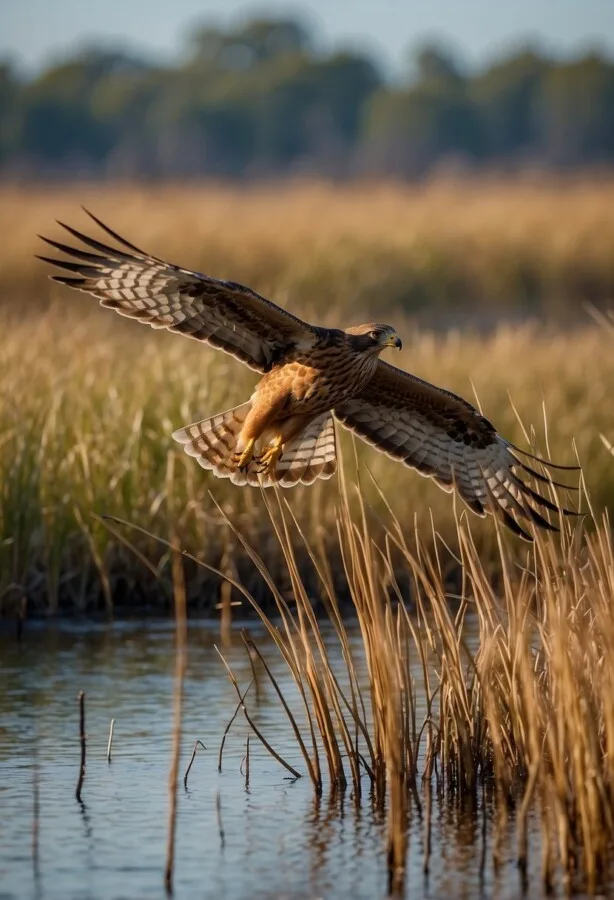
The Northern Harrier (Circus hudsonius) is a bird of prey known for its low, gliding flight over open fields. This raptor sports a long, slender body with a wingspan reaching up to 1.2 meters, distinctive for its V-shaped wing posture. Adapted for hunting, it has a facial disk akin to owls, aiding in sound localization. Males exhibit a grey plumage, while females and juveniles are brown. Found across North America, the harrier favors marshes and meadows for nesting. It primarily feeds on small mammals and birds, captured with precise aerial maneuvers. Conservation status: Least Concern.
Northern Jacana

The Northern Jacana (Jacana spinosa) exhibits a distinctive morphology, with elongated toes and claws enabling it to traverse floating vegetation. This shorebird resides across Mexico, Central America, and parts of the Caribbean. It is predominantly insectivorous, but it also consumes mollusks and seeds.
Habitat:
- Coastal regions
- Freshwater wetlands
Conservation Status:
- Least Concern
Breeding:
- Male incubates eggs (22-24 days)
- Tends to downy young upon hatching
Exceptional for their maternal role reversal, males exclusively incubate the eggs and care for the young. These birds are skillful navigators of their marshy territories, contributing to their classification as Least Concern. However, habitat preservation remains vital for their ongoing survival.
Northern Parula
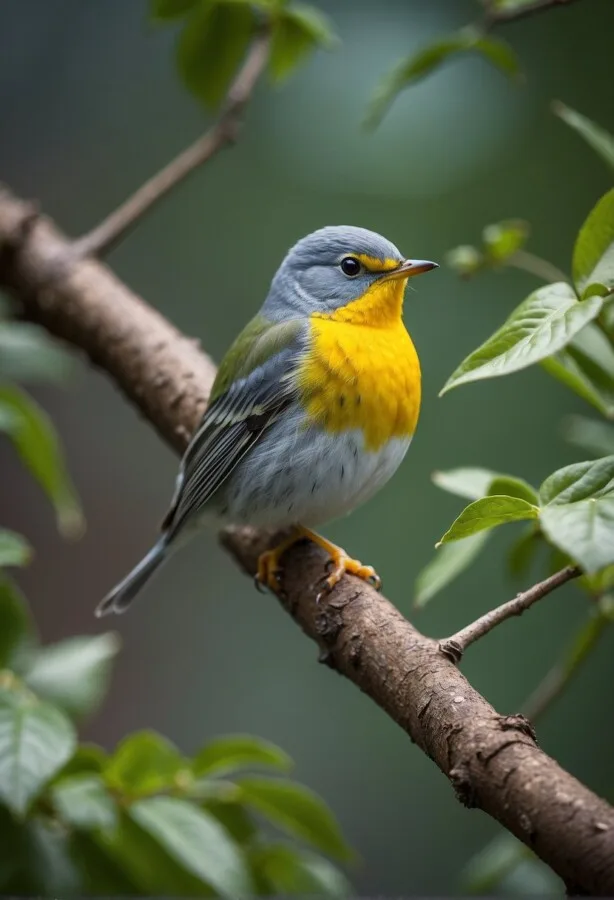
The Northern Parula, Setophaga americana, is a small, vibrant warbler with distinct yellow and blue-gray plumage. It prefers moss-laden forests for breeding, extending from Florida to southern Canada. This bird’s diet mainly consists of insects, caught as it flits through treetops. Conservation status for this species is of Least Concern, indicating stable populations. Vocalizations include a buzzy trill, with audibility peaking during the breeding season. Habitat conditions critically impact the parula’s survival, thus monitoring ecosystems is vital for their continued thriving.
Northern Pintail
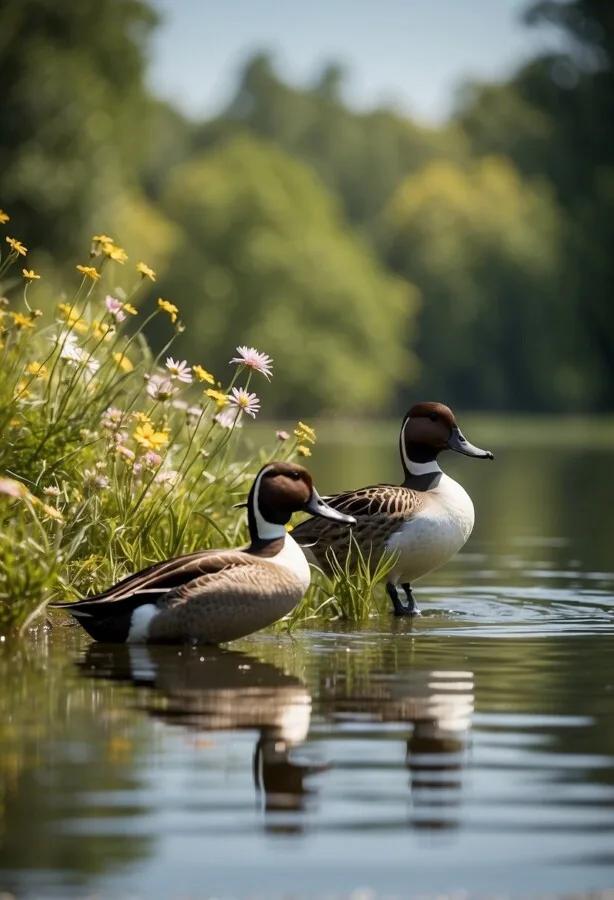
The Northern Pintail (Anas acuta) is a distinctive duck exhibiting elongated tail feathers and an elegant profile. Classified under the Order Anseriformes and Family Anatidae, this migratory species has a notable presence across multiple continents. They adapt to varied habitats including wetlands and grasslands. The conservation status of the Northern Pintail is of Least Concern, indicating a stable population. During breeding, they consume invertebrates, crucial for local ecosystems. Their broad distribution signifies their adaptability and the importance of international conservation efforts.
Northern Potoo

The Northern Potoo (Nyctibius jamaicensis) is a solitary avian, adept in nocturnal predation. Its cryptic plumage blends seamlessly with bark, aiding its daytime camouflage. At night, it hawks for flying insects. This species is categorized as of “Least Concern” by conservation status, with Central America as its native habitat.
| Feature | Detail |
|---|---|
| Conservation | Least Concern |
| Habitat | Central America |
| Behavior | Solitary or in Pairs |
| Diet | Insects; occasionally small birds |
| Reproduction | Lays eggs in tree hollows or on stumps |
These birds exhibit remarkable perching, resembling broken branches—a survival strategy against predators. Despite their elusive nature, they play a crucial role in controlling insect populations.
Northern Screamer
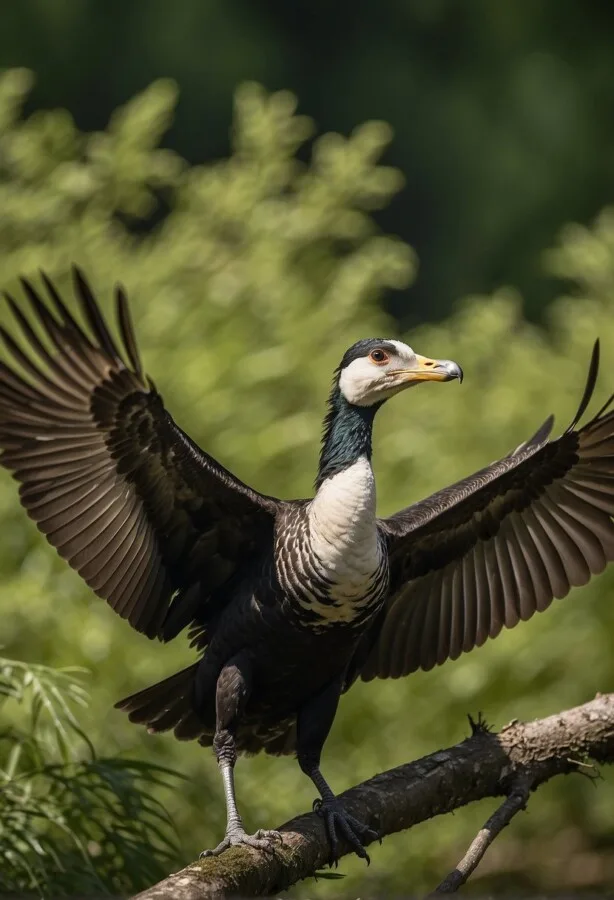
The Northern Screamer (Chauna chavaria), also known as the Chavaria, belongs to the family Anhimidae. Native to South America, this near-threatened species dwells primarily in freshwater marshes and lakeshores. Characterized by a large, goose-like body and elongated neck, they exhibit mostly grey plumage, with white wing patches prominent during flight.
Diet:
- Aquatic vegetation
- Roots
- Stems
- Grasses
- Seeds
Mating Habits:
- Monogamous pairs
Conservation Status:
- Near Threatened
Challenges to their survival include habitat loss and hunting, which have caused concern among conservationists. These creatures are essential to their ecosystems, contributing to the dispersion of aquatic plant seeds.
Northern Water Snake

Scientific Name: Nerodia sipedon
Conservation Status: Least Concern
| Characteristic | Detail |
|---|---|
| Order | Squamata |
| Family | Serpentes |
| Habitat | North America; near freshwater |
| Diet | Carnivorous; includes fish and amphibians |
The Northern Water Snake is commonly found across North America, particularly in freshwater environments. This nonvenomous snake exhibits a range of colors from brown to reddish or gray. They are characterized by dark crossbands on their neck and blotches over the body, which may become obscure with age. These reptiles are hunters, preying on fish and amphibians. Their role in their ecosystem is pivotal, as they help maintain the balance by controlling the populations of their prey.
Neapolitan Mastiff
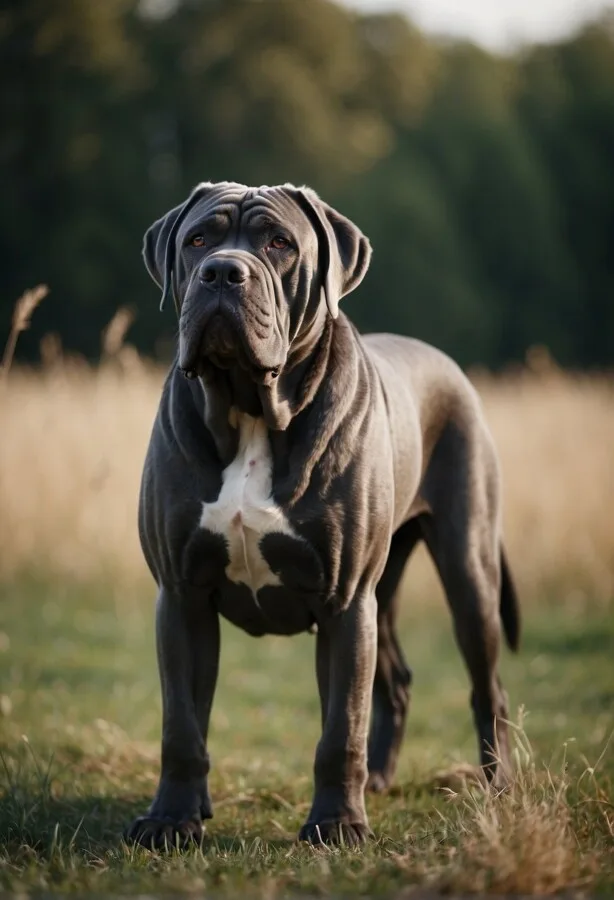
The Neapolitan Mastiff, known as Mastino Napoletano in Italian, boasts a heritage of guard dogs from Italy’s central regions. Recognized officially in 1949, this mastiff variety epitomizes a robust guardian breed. These dogs are distinguishable by their imposing physique, abundant loose skin, and tranquil yet vigilant demeanor.
Characteristics:
- Size: Large
- Temperament: Protective, Calm
- Lifespan: 8 to 10 years
- Role: Guard dog
Traditionally, these mastiffs were utilized in wartime by the Romans. Today, they are primarily family protectors and companions, exhibiting steadfast loyalty. Despite a formidable appearance, the Neapolitan Mastiff is known for a gentle interaction with familiar individuals.
Nebelung
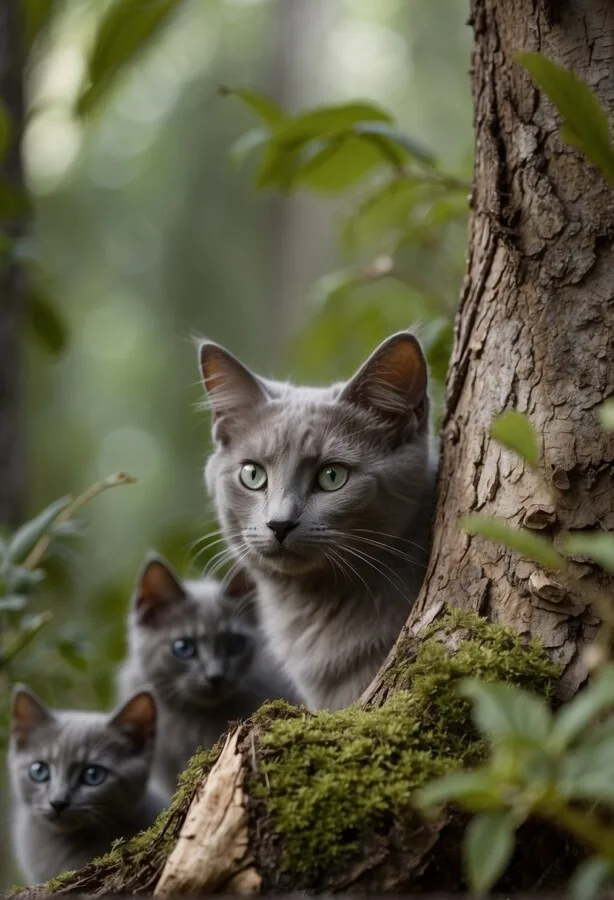
The Nebelung cat is a distinct breed, resembling a long-haired Russian Blue with a shimmering silver-blue coat. Noted for their mild disposition and affectionate nature, they thrive on companionship. Genetically, they share a close link with the Russian Blue, contributing to their striking appearance and similar temperament. Adored by enthusiasts for their regal bearing and plush double coat, Nebelungs require regular grooming to maintain their coat’s luxurious texture. As intelligent felines, they exhibit loyalty to their family, often forming strong bonds with a specific person. They adapt well to serene environments and benefit from interactive play to satisfy their mental and physical needs.
Newfoundland

Originating from Canada’s Newfoundland, the Newfoundland dog is renowned for its strength, loyalty, and swimming ability. These gentle giants possess a water-resistant double coat and webbed feet, making them exceptional swimmers. Traditionally, they’ve aided fishermen by hauling nets and rescuing potential drowning victims. Their calm nature and intelligence render them excellent family pets, while their work ethics make them suitable for search and rescue missions. Moreover, the breed’s sociability means they thrive in human companionship, reinforcing their status as cherished working dogs and companions.
Newfypoo

The Newfypoo is a cross between the Newfoundland dog and a Poodle, known for its intelligence, friendliness, and large size. These dogs commonly weigh between 70 to 150 pounds. They are often considered good with children, other dogs, and pets due to their gentle disposition. Grooming a Newfypoo can be challenging due to the breed’s thick, oily coat which may require regular maintenance. As they are not a purebred, the Newfypoo’s characteristics can vary according to the traits inherited from the parent breeds. They typically thrive in environments where they receive plenty of space and exercise.
Norwegian Buhund

The Norwegian Buhund belongs to the spitz family, a group known for their fox-like appearance and sturdy build. Originating in Norway, they were bred as a versatile farm dog capable of herding livestock and guarding homesteads. Their lineage is steeped in Scandinavian history, often associated with Viking explorers.
Size: Medium
Coat: Dense, weather-resistant
Temperament:
- Energetic
- Alert
- Loyal
Traditionally, they played a crucial role in rural Norwegian life, demonstrating an eagerness to work and an innate intelligence. These traits make them excellent companions for active owners today.
Conservation Status:
- Not listed
Living in temperate to cold climates, the Buhund adapts well thanks to its thick coat. Proper care and socialization are imperative given their high energy levels and need for mental stimulation.
Norwegian Forest

In the lush Norwegian forests, one is unlikely to encounter the Norwegian Forest dog, a term that is actually a misnomer as there is no such dog species or type associated with Norway’s woodlands. The canines of Norway are better exemplified by breeds such as the Norwegian Elkhound, a robust dog originally used for hunting elk and guarding homes. This breed symbolizes the enduring bond between Norway’s people and the natural world, embodying adaptability, strength, and a keen intelligence that is crucial for survival in Norway’s diverse ecosystems. Norway’s forest regions remain emblematic of the country’s rich biodiversity and the vital role dogs have played in its history.
Norwegian Elkhound

Originating from Norway, the Norwegian Elkhound is a robust breed, with a storied history alongside the Vikings. This Spitz-type dog is known for its silver-gray coat and a tail that curls tightly over its back. Standing about 20 inches at the shoulder, they possess a thick coat suited for cold climates.
Characteristics:
- Height: ~20 inches
- Coat: Dense, silver-gray
- Tail: Tightly curled
Temperament:
Renowned for loyalty and courage, Norwegian Elkhounds have sharp hunting skills, often used for tracking large game such as elk. They are protective, making them excellent guardians, and thrive in active environments.
General Care:
Regular exercise and mental stimulation are essential, given their energetic nature. Proper grooming is also important due to their dense coat.
This breed’s versatility and strong instinct make it a valued companion both in past and modern times.
See Related: Giant Panda: Why Are Pandas Endangered?
Norwegian Lundehund

The Norwegian Lundehund, originating from Værøy island, is a small Spitz breed recognized for its unique anatomical adaptations. This breed is distinguished by its remarkable flexibility and six-toed paws, traits honed for maneuvering rocky cliffs in puffin hunting. Although no longer used for such purposes due to puffin protection, these dogs have transitioned well to companionship roles. Selected for their agility and problem-solving skills, the Lundehund exhibits a cheerful demeanor, suited for active homes.
- Flexibility: Exceptional joint rotation
- Toes: Six on each foot
- Origin: Værøy, Norway
- Purpose: Historically puffin hunting; now a companion
- Temperament: Bright, friendly
Norwich Terrier

The Norwich Terrier, a small but hardy breed, originates from England. Active and courageous, this dog possesses a wiry coat that comes in a variety of colors such as red, black and tan, or grizzle. Standing no taller than 10 inches at the withers, the Norwich weighs between 11 to 12 pounds.
Characteristics:
- Lifespan: 12-15 years
- Temperament: Affectionate, alert, and stubborn
Health:
- Prone to: Hip dysplasia, eye issues, and upper airway syndrome
Despite their size, Norwich Terriers are vigorous and have a history in vermin hunting, showcasing a strong prey drive. They thrive in active families and require regular mental stimulation and exercise. Their grooming needs include regular brushing and occasional stripping of their coat to maintain its texture and appearance. As sociable pets, they bond closely with their owners, displaying a cheerful disposition.
Nabarlek

Nabarlek (Petrogale concinna), a marsupial indigenous to northern Australia, falls within the rock-wallaby family. They lead a mostly solitary lifestyle and are identified by their unique dental traits, akin to sharks, as molars continually emerge at the rear. However, unlike the fearsome marine predator, Nabarleks are diminutive, nocturnal creatures.
Conservation Status:
- Category: Endangered
- Primary Threats: Habitat loss, predation
Characteristics:
- Diet: Herbivorous
- Habitat: Rocky outcrops
- Behavior: Solitary
- Reproduction: Joeys stay in pouch
Efforts to preserve its numbers are crucial, given its vulnerable status.
Naegleria

Naegleria, a genus of free-living amoebae, thrives in warm, freshwater environments globally. Comprising 47 species, these unicellular organisms undergo a complex life cycle: amoeboid, cyst, and flagellated stages. Naegleria fowleri, notorious as the “brain-eating amoeba,” poses a risk to humans, causing rare but severe infections. Typically feeding on bacteria, these protists are not truly amoebas, but amoeboflagellates. They’re studied for their environmental adaptability and ability to transform between life stages.
Nelore Cattle
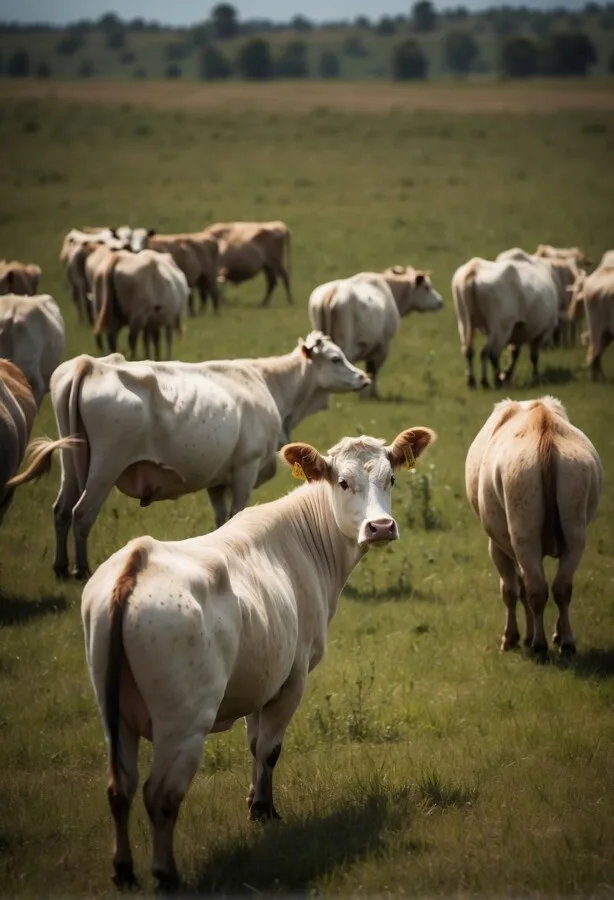
Nelore cattle, Bos indicus, are of Indian origin and thrive in tropical regions. Recognizable by their distinctive hump over the shoulder, they sport a silver-white coat. Nelore cattle have long legs, an adaptation for waterlogged grazing. With a population size of around five million, these cattle are a dominant beef-producing breed, accounting for approximately 65% of the global beef population. They exhibit a docile temperament, with a gestation period of about 291 days, typically leading to a single calf per birth.
Netherland Dwarf Rabbit
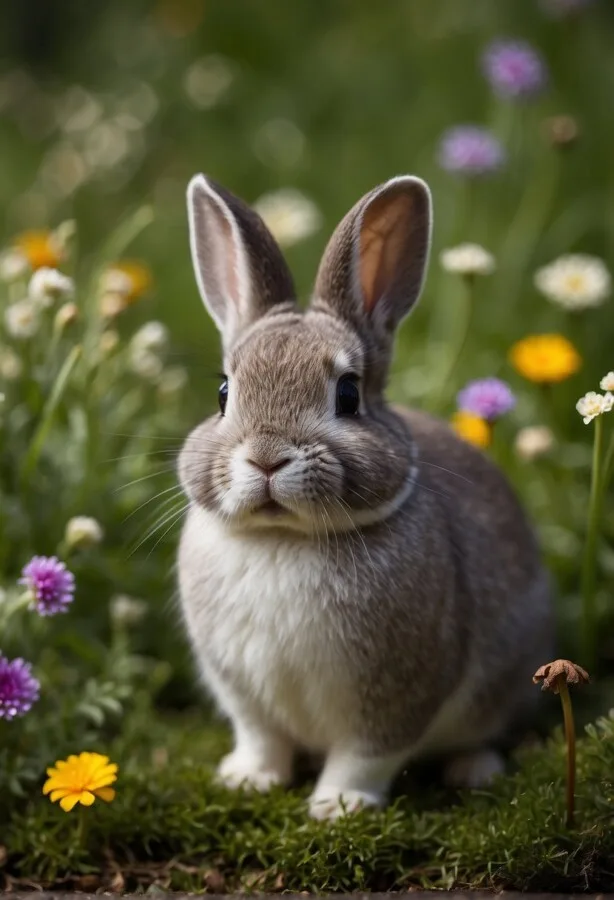
The Netherland Dwarf Rabbit is a notably small breed, with adults typically weighing between 1.1 to 2.5 pounds. Originating in the Netherlands, its compact size is complemented by short, muscular legs, a rounded face with large eyes, and ears that stand erect. This breed demonstrates a wide spectrum of coat colors and patterns. Known for their energetic temperament, Netherland Dwarfs require a spacious environment for adequate exercise and thrive on a diet rich in hay, fresh vegetables, and a controlled amount of pellets. Their diminutive stature and engaging appearance have propelled them to be a cherished pet and show animal worldwide.
New Hampshire Red Chicken

The New Hampshire Red chicken, a breed of Gallus gallus domesticus, was developed from the Rhode Island Red in the early 20th century in the United States. Characterized by its early maturity and fast growth, it is known for a meaty carcass and a more triangular body shape. This breed has a deep, broad body, appearing large and plump with feathering predominantly in a lighter shade of red. New Hampshire Reds are hardy birds, adapting well to different environments and are often praised for their good egg production.
Nicobar Pigeon

The Nicobar Pigeon (Caloenas nicobarica) is not just another bird; it’s the closest living relative to the extinct dodo. With a distinctive glistening plumage, predominantly green with copper highlights, this pigeon is more than meets the eye. Native to Asia and Oceania, they inhabit dense forests in flocks, foraging on the forest floor predominantly for seeds and invertebrates. Classified as ‘Near Threatened’ on the IUCN Red List, the pigeon’s main threat comes from habitat loss and invasive predators. Protecting these birds calls for urgent conservation measures.
Nguni Cattle
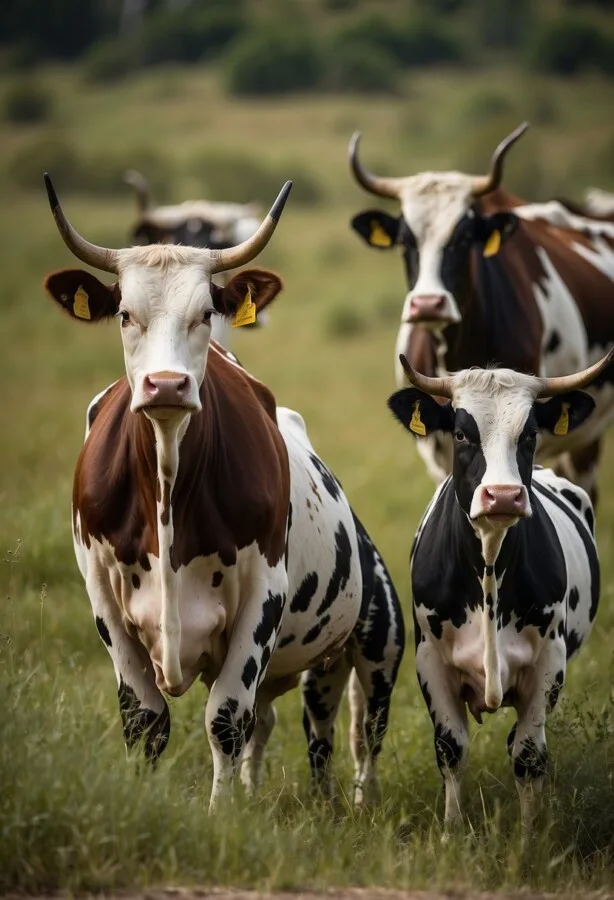
Nguni cattle are a resilient breed indigenous to Southern Africa, lauded for their adaptability and patterned hides. These animals are crucial to the region’s agricultural landscape, thriving in harsh environments where other breeds might falter. They have a strong resistance to local diseases and parasites, making them a low-maintenance livestock for farmers.
Characteristics:
- Origin: Southern Africa
- Resistance: High disease and parasite resistance
- Use: Agriculture, cultural significance
- Temperament: Docile
Through selective breeding, Nguni cattle exhibit a variety of vibrant coat patterns, contributing to their popularity and cultural importance among the Nguni people. They are primarily used for their meat and hides, playing a vital role in the local economy. As a sociable herd animal, Nguni cattle form the backbone of many community-based farming initiatives, promoting sustainability and self-sufficiency in the region.
Nigerian Goat

The Nigerian Goat, Capra aegagrus hircus, is a small dairy breed. High milk production relative to their size and a docile disposition characterize these animals. They adapt well to various climates and are noted for their high butterfat content in milk, making their dairy products particularly rich and creamy.
Characteristics:
- Size: Small
- Coat: Varies in color/pattern
- Lifespan: 10-15 years
Milk Production:
- Quantity: Abundant for size
- Butterfat: High
Thriving in diverse environments, Nigerian Goats require minimal upkeep. Their friendly nature and manageable size also make them popular pets.
Nubian Goat
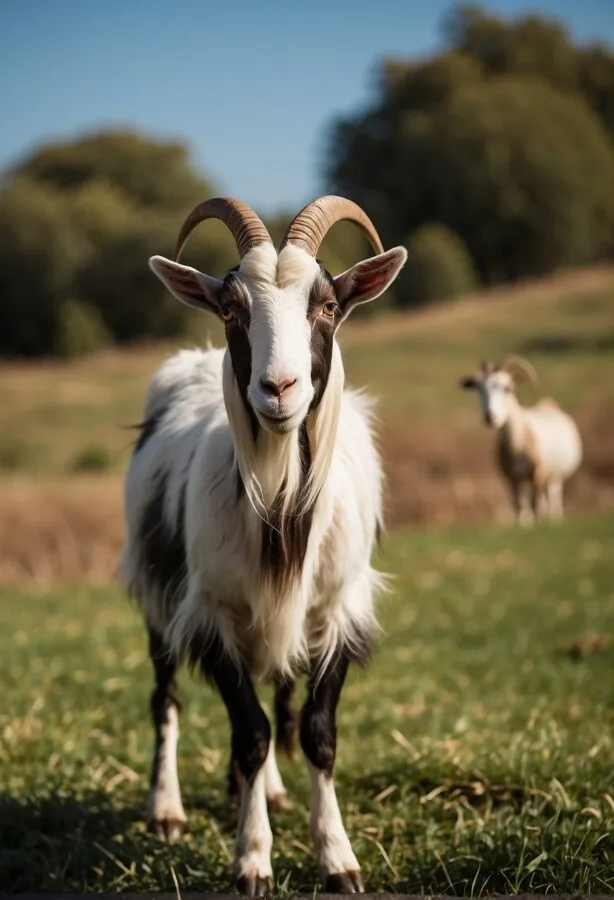
The Nubian Goat, belonging to the species Capra aegagrus hircus, is distinguishable by its long, floppy ears and convex profile. Primarily raised for dairy production, these goats are recognized for their high butterfat content milk. Adapted to hot climates, Nubians’ origin traces back to the Middle East and North Africa, and they are now prevalent in many countries.
Characteristics:
- Ears: Long, pendulous
- Profile: Convex, Roman nose
- Coat: Short hair, various colors
- Purpose: Dairy (high butterfat milk)
They live in herds and exhibit a sociable nature. While classified as livestock, their conservation status currently remains unassessed.
Nematode

Nematodes, colloquially known as roundworms, are a prolific phylum that plays a critical role in soil health and ecosystem balance. They are characterized by their elongated, cylindrical bodies and inhabit a multitude of environments from terrestrial to aquatic.
- Diet: Mostly decomposers, some parasitic
- Size: Typically microscopic, varies widely
- Reproduction: Both sexual and asexual
Research suggests nematodes comprise a significant portion of Earth’s biodiversity, with estimates that 80% of all individual animals on the planet may be nematodes. Their presence is key in nutrient cycling, yet some species are known to impact human health negatively as parasites.
Nerka

The Nerka, commonly known as sockeye salmon, is a species of salmon famed for its striking red hue during spawning. They are anadromous, migrating from ocean habitats to freshwater spawning grounds. Their lifecycle begins in natal rivers, leads to years in the Pacific Ocean, and concludes upon returning to freshwater to reproduce. Sockeye are integral to indigenous cultures and local ecosystems.
- Habitat: Pacific Ocean, freshwater for spawning
- Diet: Zooplankton, small fish
- Life Cycle: Anadromous, oceanic phase and spawning migration
Conservation status varies, with some populations considered at risk, emphasizing the need for sustainable fishing practices and habitat protection.
Nettlefish
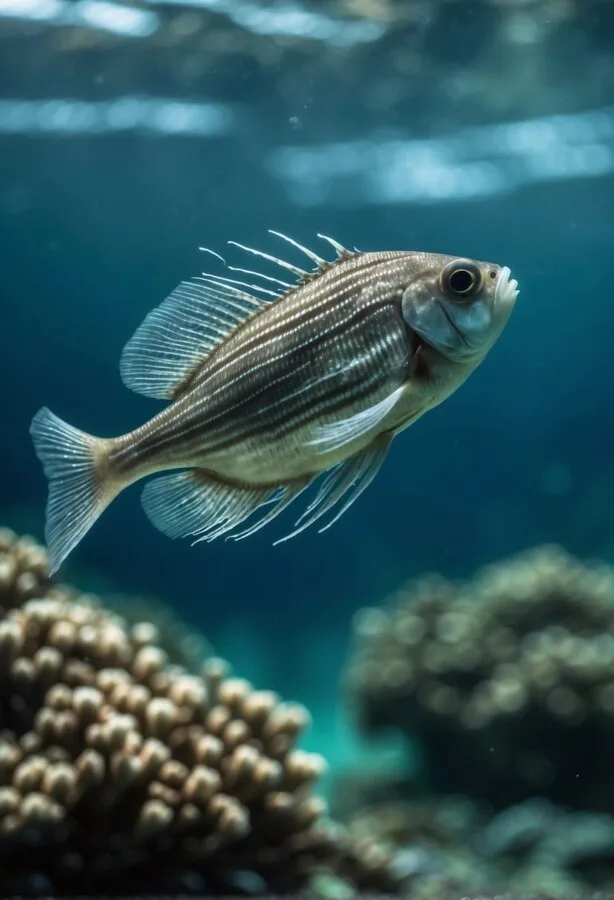
Nettlefish, not to be confused with jellyfish, are a lesser-known species in the marine world. Characteristically, they possess venomous spines, which deter predators and aid in hunting. In their habitat, typically tropical and subtropical waters, nettlefish rely on camouflage, blending seamlessly with sandy ocean floors. While details on their population are scant, they are subject to risks like overfishing and habitat loss. Efforts to study and conserve nettlefish are crucial, as they play a vital role in marine ecosystems.
Nudibranch
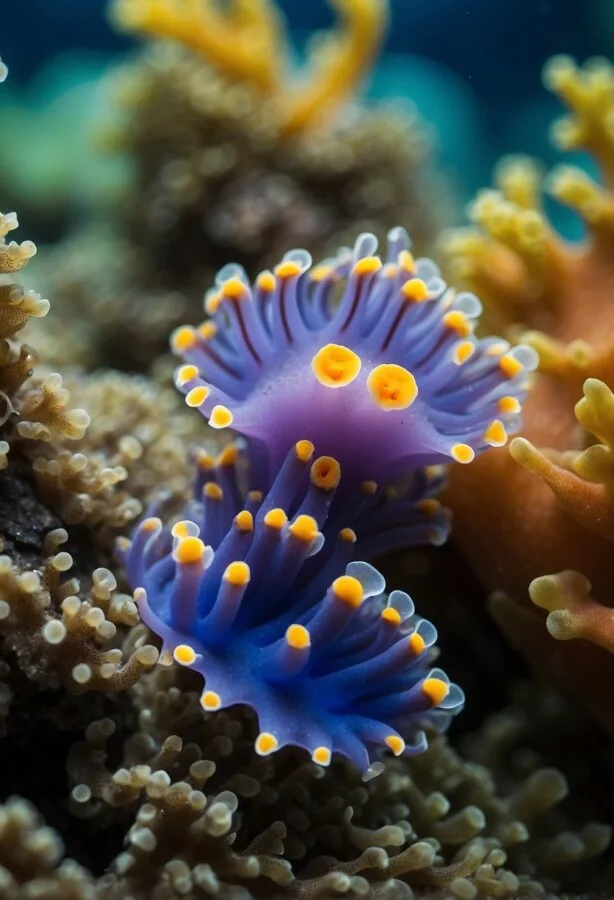
Nudibranchs, soft-bodied marine mollusks, display a kaleidoscope of colors and intricate patterns. These sea slugs thrive from shallow reefs to depths exceeding 700 meters. Classified into numerous species, they possess unique adaptations like toxic defenses and gas-filled sacs for buoyancy. Despite their varied habitats, nudibranchs share a common trait: they’re all benthic, crawling along substrates as they feed mainly on sponges and other small sea creatures. Conservation of their ecosystems is critical, as their presence indicates healthy underwater biodiversity.
Naked Mole Rat

The naked mole rat (Heterocephalus glaber) is a unique burrowing rodent found in East Africa. Notable for its longevity, it thrives in high carbon dioxide environments with low oxygen levels. Biologically remarkable, this mammal utilizes fructose to withstand hypoxic conditions, a trait singular to its species. Its eusocial structure resembles that of ants, with a queen and workers. Naked mole rats’ cancer-resistant nature adds to their scientific intrigue, making them subjects of extensive research in health science.
Neanderthal

The Neanderthals (Homo neanderthalensis) were not animals, but a subspecies of archaic humans. Flourishing across Eurasia, they exhibited skills in tool-making and possibly language. Evidence suggests Neanderthals engaged in ritualistic practices and created early cave art. Despite their extinction approximately 40,000 years ago, they contributed genetically to modern humans, as revealed by DNA studies. Their ability to adapt to diverse habitats underscores the complexity of hominin evolution.
Nebelung

The Nebelung cat is a distinctive breed revered for its luxurious blue-grey coat and vivid green eyes. A creature of serene demeanor, it emanates grace akin to its Russian Blue ancestors. This medium-sized feline embraces a reserved nature, often displaying loyalty to a select few. The breed’s physical characteristics include a long, slender body and a dense, silky fur, requiring regular grooming. Enigmatic and gentle, the Nebelung thrives in tranquil environments and forms profound bonds with its human companions. As an omnivore, its dietary needs are similar to other domestic cats. Notably not listed as a conservation concern, this breed’s status as a companion animal remains secure.
Needlefish

Needlefish (Belonidae) are slender, marine fish recognized by their elongated jaws and sharp teeth. They inhabit shallow waters and are known for their surface-skimming feeding behavior. Their diet primarily consists of smaller fish, which they deftly impale.
- Conservation Status: Least Concern
- Habitat: Tropical and subtropical oceans worldwide
They display remarkable agility and can leap above water, posing risks to unwary boaters. Needlefish reproduction involves laying eggs with tendrils adhering to floating debris. Despite their low commercial value, they contribute significantly to the marine food web.
Neon Tetra
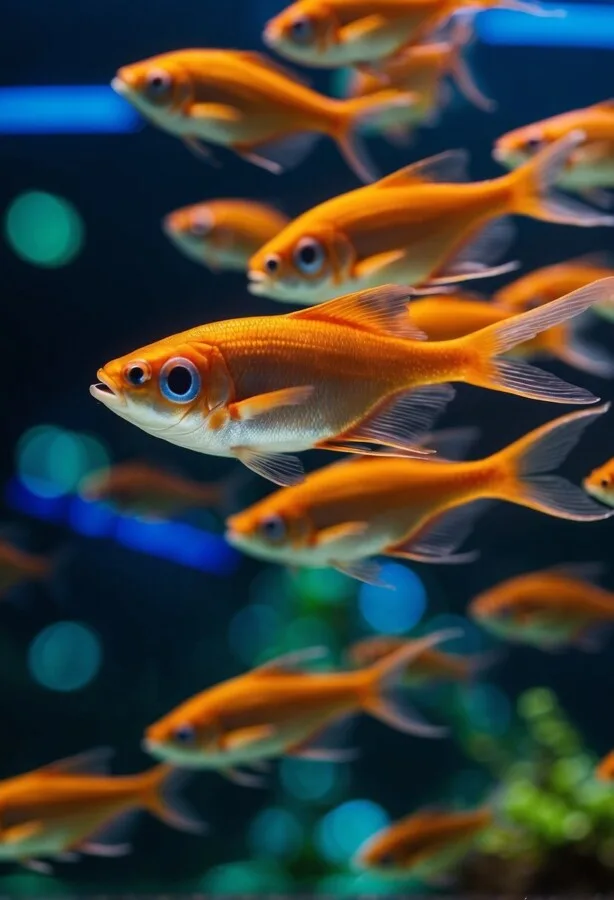
The Neon Tetra (Paracheirodon innesi) is a vibrant freshwater fish native to South American rivers, particularly the Amazon Basin. Recognizable by its iridescent blue body and red stripe, this small fish typically reaches just 1.5 inches in length. In the wild, Neon Tetras thrive in schools, displaying intricate social behaviors and preferring dimly-lit environments.
Habitat
- Origin: Amazon River Basin
- Environment: Freshwater, blackwater streams
Characteristics
- Size: Up to 1.5 inches
- Body: Blue with a red stripe
- Social Structure: Schooling fish
- Conservation Status: Least Concern
These fish are prominent in home aquariums due to their peaceful nature and ease of care. Conservation-wise, they are classified as ‘Least Concern’ by the IUCN, reflecting their stable wild populations.
Neptune Grouper
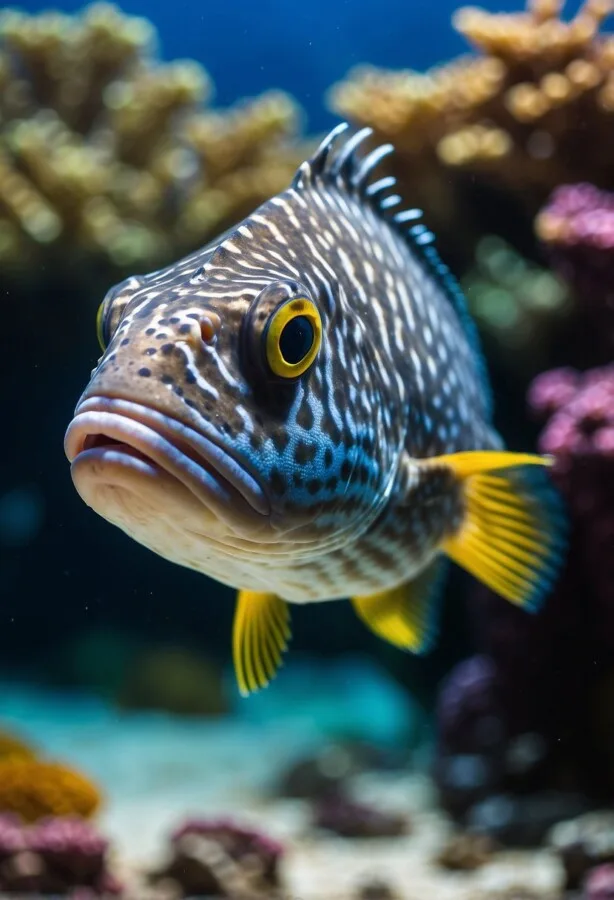
The Neptune Grouper (Cephalopholis igarashiensis) thrives primarily in Asian and Oceanian waters. While it is classified as “Least Concern” on the IUCN Red List, this striking fish with hues of pink and yellow is elusive, often dwelling in deep reefs. It is part of the Serranidae family, which indicates its relation to groupers commonly found in coral and rock habitats. The Neptune Grouper’s diet consists of smaller prey that coexist in its marine surroundings.
| Classification | Information |
|---|---|
| Kingdom | Animalia |
| Phylum | Chordata |
| Class | Actinopterygii |
| Order | Perciformes |
| Family | Serranidae |
| Genus | Cephalopholis |
| Scientific Name | Cephalopholis igarashiensis |
Due to its deep-sea habitat, encounters with divers are rare, which contributes to its mystique and allure among marine biologists and enthusiasts.
Nguni Cattle

Nguni cattle, indigenous to Africa, are distinguished by their multi-colored hides and resistance to local diseases. They are a mix of Bos taurus and Bos indicus. Notably, these cattle adapted to local conditions over thousands of years, becoming integral to the livelihoods of the Nguni people. Due to their hardiness and efficient meat production, Nguni cattle are important to sustainable farming practices. With a legacy spanning over 8,000 years, they remain a symbol of heritage and resilience in African agriculture.
See Related: What is the Lion Extinction Status? The Alarming Decline of Africa’s Majestic Predators
Nicobar Pigeon

The Nicobar Pigeon (Caloenas nicobarica) is recognized for its shimmering feathers. It’s the sole extant member of its genus, conferring it a unique evolutionary position among pigeons. Inhabiting regions across Southeast Asia and the Pacific, including the Andaman and Nicobar Islands, these birds prefer dense forests on isolated islands to evade predators. Their diet is omnivorous, primarily consisting of seeds, fruit, and invertebrates. Conservation status for the Nicobar Pigeon is currently “Near Threatened” due to habitat loss and predation by introduced species.
Nigerian Goat

The Nigerian Goat, a subgroup of West African Dwarf goats, thrives in a variety of habitats. These robust animals are social, often seen in herds, and are identified by their compact bodies and short stature. One notable aspect is their reproduction; they’re polyestrous, breeding year-round with a gestation period of roughly 150 days.
Physical Characteristics:
- Size: Small, stature not exceeding 23 inches
- Coat: Varies; short, fine fur
Habitat: Adaptable to diverse environments, they’re prevalent in domestic settings across Africa and North America.
Diet: Herbivorous, primarily browsers.
Lifespan: Average 10 to 15 years.
Uses: Valued for their milk, meat, and as companion animals. The milk is rich in butterfat, making it sought after for cheese production.
Night Heron

The Black-Crowned Night Heron (Nycticorax nycticorax) stands out with its compact frame, reaching two feet in height and a mass close to two pounds. Its legs are shorter, and it noticeably lacks the elongated, serpentine neck typical of herons. The species exhibits adaptability in habitat selection, thriving in diverse environments across continents, from Africa to North and South America, as well as Asia and Europe. As a nocturnal feeder, it preys on a variety of aquatic organisms. These birds maintain a Least Concern conservation status, indicating stable populations.
Nile Monitor

The Nile monitor (Varanus niloticus) is a formidable member of the Varanidae family, thriving in most of Sub-Saharan Africa and along the Nile. Recognized as one of the largest lizards globally, these reptiles can reach lengths of 1.5 to 2.1 meters. Nile monitors are diurnal, typically found basking on riverbanks or foraging for diverse prey, including fish, birds, and invertebrates. Classified as “Least Concern,” their conservation status reflects a current stable population, highlighting their adaptability and ecological success.
Nilgai

The Nilgai (Boselaphus tragocamelus), a member of the family Bovidae, stands as Asia’s largest antelope. Mature males, distinguished by their blue-grey coats, earn them the moniker ‘blue bull’. Females and juveniles sport tawny brown fur. An herbivorous animal, the Nilgai prefers grasslands and woodlands where it grazes on grasses, leaves, and fruits.
Habitat & Behavior:
- Location: Asia, introduced in Texas, USA
- Group Dynamics: Sociable; females form herds, males solitary or in bachelor groups
Conservation Status:
- Least Concern: Adjusts well to human-disturbed areas, though habitat loss is a concern
Reproduction:
- Offspring Name: Calf
- Gestation Period: Around 258 days
No See Ums

No See Ums are minuscule flies from the family Ceratopogonidae. They inhabit diverse regions, including Africa and North America. With over 5,000 species globally, they display adaptability to various ecosystems. These insects‘ bites can be irritating, as they feed on blood. Commonly found near water, No See Ums thrive in both larval and adult stages in moist environments. Their conservation status is of the least concern, reflecting their vast populations. Despite their nuisance to humans, No See Ums play a vital role in the food web, serving as prey for various animals.
Norfolk Terrier

The Norfolk Terrier, a diminutive yet hearty breed, belongs to the Canidae family. Originating in Europe, specifically England, these terriers are recognized for their hard, wiry coat and affectionate nature. Typically standing no more than 10 inches at the shoulder, they carry a balanced omnivorous diet.
Characteristics:
- Size: Small, up to 10 inches tall
- Weight: Approximately 12 pounds
- Coat: Hard, wiry, straight
- Diet: Omnivore
Though not listed on conservation status, maintaining purebred standards is vital for the breed’s continuity. The Norfolk Terrier excels as a companion with its endearing personality and manageable size.
Norrbottenspets

The Norrbottenspets, a spitz-type breed, holds its origins in Sweden. Characterized by a compact, muscular frame, this breed stands with alertness, boasting large ears and a keen sense for hunting. Males typically reach 17 to 18 inches in height and weigh between 24 and 33 pounds, while females share the same stature but tip the scales at a lighter 18 to 26 pounds. They excel in wooded environments, utilizing their sharp senses to track game. Upon detection, they energetically pursue and corner prey, their bark and agile movements aiding hunters in the capture.
North American Black Bear

The North American Black Bear (Ursus americanus), residing across North America, represents the continent’s smallest and most widespread bear species. Considered of Least Concern by conservation statuses, it exhibits diverse coloration from black to cinnamon. It preys mostly on fruits, nuts, and rodents, and young bears are referenced as cubs. This species’ adaptability sees it across varied habitats, from forests to swamps. With sixteen subspecies, including the Kermode, cinnamon, and glacier bears, genetic and appearance variations are minor. Their significant role within the ecosystem encapsulates the balance of their natural environments.
Northern Inuit Dog

The Northern Inuit Dog is a breed known for its wolf-like appearance, yet it possesses a temperament that is both intelligent and amiable. They typically weigh between 55-110 pounds with a lifespan of 12-14 years. Adaptability to family life makes them suitable companions for homes with older children. Originating from a mix resembling German Shepherds and Siberian Huskies, the Northern Inuit Dog requires rigorous physical activity, thrives on human companionship, and fares best with consistent training. Despite not being officially recognized as a distinct breed, these dogs have garnered attention for their striking looks and loyal nature.
Northern Alligator Lizard

The Northern Alligator Lizard (Elgaria coerulea) resides primarily in North America. This reptile is part of the Anguidae family and is recognized for its distinctive elongated body and short limbs.
Physical Traits:
- Coloration: Brown to green with yellowish undertones.
- Size: Typically between 3 to 7 inches in length.
Habitat:
- Prefers brushlands, wooded areas, and grasslands.
Diet:
- Carnivorous; includes mealworms, crickets, and tiny rodents.
Conservation Status:
- Classified as ‘Least Concern’ due to a stable population.
Needlefish

Needlefish (family Belonidae) are slender, elongated fish found in tropical and subtropical oceans worldwide. They are characterized by their long, beak-like jaws filled with sharp teeth. Needlefish typically swim close to the water’s surface, where they prey on smaller fish and crustaceans.
| Feature | Description |
|---|---|
| Habitat | Tropical/Subtropical oceans |
| Diet | Small fish, crustaceans |
| Reproduction | Lay eggs in shallow water |
Noted for their surface-dwelling behaviors, needlefish are capable of making short glides above the water. During mating season, females lay eggs in shallow waters, adhering them to objects in the sea. Conservation-wise, most needlefish species are of least concern, with stable populations across their habitats.
Neptune Grouper
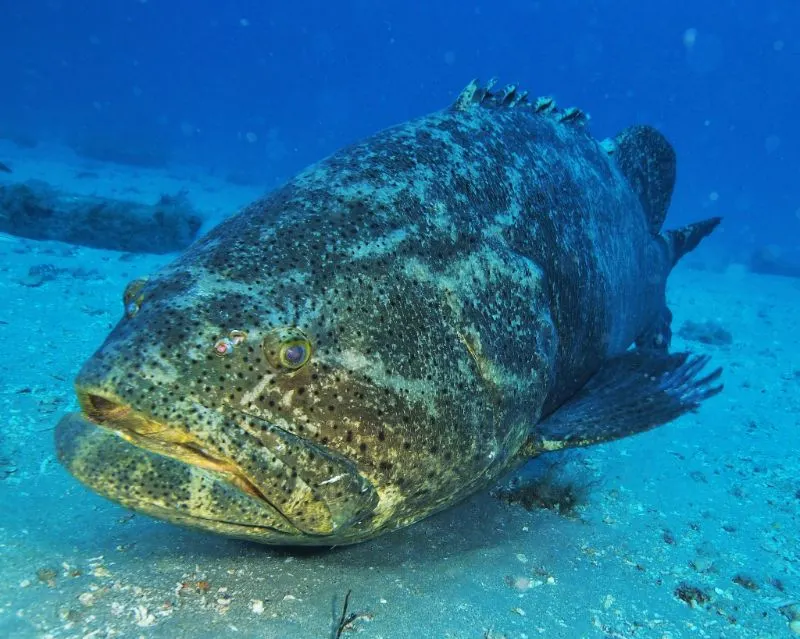
The Neptune Grouper (Cephalopholis igarashiensis) exhibits a vibrant coloration, primarily an amalgamation of pink and yellow hues. This marine species belongs to the Serranidae family and is often found in the Indo-Pacific waters. Recognized by the IUCN Red List as “Least Concern,” the species thrives in deep reef environments.
Habitat:
- Location: Asia, Ocean, Oceania
- Environment: Deep reefs
Conservation Status:
- IUCN Red List: Least Concern
Despite their stable population, Neptune Grouper’s niche habitats necessitate monitoring to ensure persistent environmental changes do not threaten their numbers.
Nurse Shark

The Nurse Shark (Ginglymostoma cirratum) is a sedentary, bottom-dwelling fish known for its unique habitats in warm, shallow waters of the western Atlantic and eastern Pacific Oceans. Recognizable by their elongated bodies and rounded snouts, these sharks often rest idly on the seabed. Notably, they possess barbels, whisker-like organs near the mouth, enhancing their sensory capabilities to locate prey such as squid and fish. Despite a somewhat sluggish disposition, their conservation status warrants attention, with a classification of “Near Threatened” due to habitat disruption and human interference.
Related Resources:
- Sustainable Fishery Practices: The Path to Healthy Oceans and Sustainable Fishing
- Are Sharks Tetrapods? Exploring Their Evolutionary Classification
- Blue Birds: A Comprehensive Guide to Identification and Habitats


